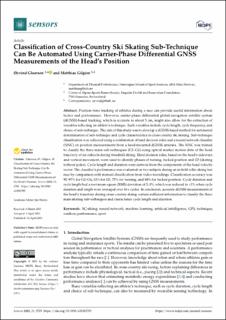| dc.contributor.author | Gløersen, Øyvind Nøstdahl | |
| dc.contributor.author | Gilgien, Matthias | |
| dc.date.accessioned | 2021-12-08T14:51:02Z | |
| dc.date.available | 2021-12-08T14:51:02Z | |
| dc.date.created | 2021-05-27T15:44:27Z | |
| dc.date.issued | 2021 | |
| dc.identifier.citation | Sensors. 2021, 21(8), Artikkel 2705. | en_US |
| dc.identifier.issn | 1424-8220 | |
| dc.identifier.uri | https://hdl.handle.net/11250/2833436 | |
| dc.description | This article is an open access article distributed under the terms and conditions of the Creative Commons Attribution (CC BY) license (https://creativecommons.org/licenses/by/4.0/). | en_US |
| dc.description.abstract | Position–time tracking of athletes during a race can provide useful information about tactics and performance. However, carrier-phase differential global navigation satellite system (dGNSS)-based tracking, which is accurate to about 5 cm, might also allow for the extraction of variables reflecting an athlete’s technique. Such variables include cycle length, cycle frequency, and choice of sub-technique. The aim of this study was to develop a dGNSS-based method for automated determination of sub-technique and cycle characteristics in cross-country ski skating. Sub-technique classification was achieved using a combination of hard decision rules and a neural network classifier (NNC) on position measurements from a head-mounted dGNSS antenna. The NNC was trained to classify the three main sub-techniques (G2–G4) using optical marker motion data of the head trajectory of six subjects during treadmill skiing. Hard decision rules, based on the head’s sideways and vertical movement, were used to identify phases of turning, tucked position and G5 (skating without poles). Cycle length and duration were derived from the components of the head velocity vector. The classifier’s performance was evaluated on two subjects during an in-field roller skiing test race by comparison with manual classification from video recordings. Classification accuracy was 92–97% for G2–G4, 32% for G5, 75% for turning, and 88% for tucked position. Cycle duration and cycle length had a root mean square (RMS) deviation of 2–3%, which was reduced to <1% when cycle duration and length were averaged over five cycles. In conclusion, accurate dGNSS measurements of the head’s trajectory during cross-country skiing contain sufficient information to classify the three main skating sub-techniques and characterize cycle length and duration. | en_US |
| dc.language.iso | eng | en_US |
| dc.subject | artificial intelligence | en_US |
| dc.subject | GPS | en_US |
| dc.subject | machine learning | en_US |
| dc.subject | neural network | en_US |
| dc.subject | outdoor | en_US |
| dc.subject | performance | en_US |
| dc.subject | sport | en_US |
| dc.subject | technique | en_US |
| dc.subject | XC-skiing | en_US |
| dc.title | Classification of cross-country ski skating sub-technique can be automated using carrier-phase differential GNSS measurements of the head's position | en_US |
| dc.type | Peer reviewed | en_US |
| dc.type | Journal article | en_US |
| dc.description.version | publishedVersion | en_US |
| dc.rights.holder | © 2021 by the authors | en_US |
| dc.source.pagenumber | 16 | en_US |
| dc.source.volume | 21 | en_US |
| dc.source.journal | Sensors | en_US |
| dc.source.issue | 8 | en_US |
| dc.identifier.doi | 10.3390/s21082705 | |
| dc.identifier.cristin | 1912329 | |
| dc.description.localcode | Institutt for fysisk prestasjonsevne / Department of Physical Performance | en_US |
| dc.source.articlenumber | 2705 | en_US |
| cristin.ispublished | true | |
| cristin.fulltext | original | |
| cristin.qualitycode | 1 | |
